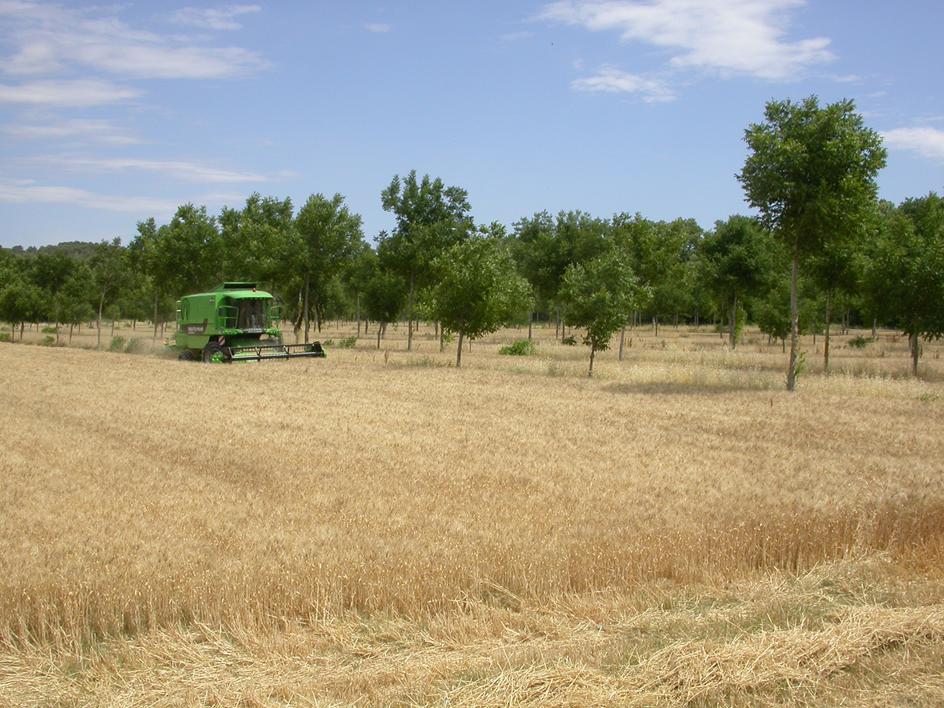
Les systèmes agrisylvicoles méditerranéens en France.
Description du système
La haute variabilité saisonnière des pluies dans la région méditerranéenne du Sud de la France limite les récoltes arables. Il y a des périodes de grandes pluies en automne, et des périodes où l'eau manque au printemps et en été. Dans une telle situation, dans les endroits où les sols sont profonds et peuvent retenir beaucoup d'eau, les systèmes agrisylvicoles (l'inclusion d'arbres en ligne dans les champs) peut améliorer l'infiltration de l'eau, limiter l'évaporation, at diminuer les besoins en eau de pluie de la plante.
Première réunion des parties-prenantes.
La première réunion des parties-prenantes s'est tenue le 2 Octobre 2014 et a inclu une visite sur la parcelle expérimentale de l'INRA Mauguio et les systèmes agrisylvicoles à Restinclières. Les recherches en court à Mauguio comprennent la sélection variétale de céréales. Les systèmes à Restinclières incluent des combinaisons de céréales avec des noyers, de céréales avec des peupliers, et de vignobles. Les agriculteurs présents ont identifié comme éléments-clefs positifs des systèmes agrisylvicoles la diversité de revenus, la production de cultures, l'augmentation de la biodiversité et habitats de la faune sauvage, et la conservation des sols. Les problèmes majeurs étaient liés aux opportunités de marchés, au manque de liquidités financières, et aux pertes des cultures liées aux limaces, aux cerfs et aux sangliers. Les aires de recherches potentielles incluent la sélection de variétés de blé dur appropriées aux systèmes agrisylvicoles.
Si vous souhaitez en savoir plus sur les activités de ce groupe, veuillez contacter le Dr Marie Gosme (marie.gosme@supagro.inra.fr) at INRA.
Download the initial stakeholder report
An initial report was produced in October 2014.
Download the initial research and development protocol
This stakeholder group has produced two protocols: the first is focused on the selection of durum wheat varieties for agroforestry and the second is focused on weed management in silvoarable systems.
Download the system descriptions
Two system description reports providing an update on the selection of durum wheat varieties and weed management were produced in January 2016.
Lessons learnt
In the first report, Marie Gosme and Dominique Desclaux describe the lessons learnt from screening durum wheat cultivars for their suitability in agroforestry systems in Mediterranean France. Up to 45 cultivars were compared in control and agroforestry conditions in up to three sites for up to three seasons. Crops under agroforestry conditions received between 40 and 75% of the light available in unshaded areas. Mean yields were low in 2015, were about 1.9 t/ha in 2016 and 2.7 t/ha in 2017. The cultivars showed large variability in their suitability for agroforestry conditions with yield differences in agroforestry compared to full sun conditions ranging from -62% to +77 %. Old varieties and varieties based on populations were not systematically more adapted to agroforestry than newer or pure-line cultivars.
In the second report, Delphine Mézière and colleagues at INRA in Southern France measured the effect of the tree-rows within silvoarable systems on the species and abundance of weeds, relative to open field conditions, over 2015 and 2016. Herbicide use was limited to a single post-winter spray. In the barley crop in 2015, on average about seven weed species/m² were found in the arable section of the agroforestry plot, compared to six species/m² in the open arable field. The number of weed individuals was lower in the agroforestry arable crop (about 50/m2) than in the open field (about 75/m2). With a pea crop in 2016 there was some evidence that the weed abundance in the crop was higher in the crop margin (next to the tree row) than in the centre of the arable alley.